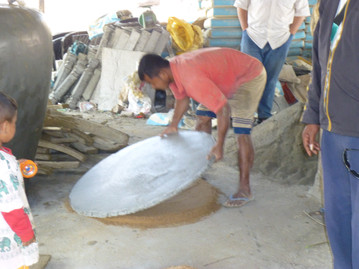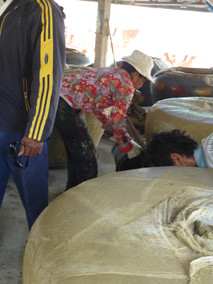Cambodia: Talents and Tastes
- Bev Baraka
- May 4, 2022
- 5 min read

There is so much to see in Cambodia but you have to pick what you want to see - unless you are back-packing through, you won't have time to see it all. Once in Phnom Penh we wanted to see some of the crafts -- the locals are talented! There is amazing wood carving, stone work, clay vessels, weaving and always - food! We were able to see how some of these things were made on a tour by a tuk-tuk.
Pottery:
I love clay vessels and wish I was talented enough to create awesome pottery but for now I'll have to let the experts do their stuff. We stopped to see how big clay urns were made. I can't remember if we intentionally went there or if it was part of a tour. It was not quite what I expected though. It is not what you would think for typical pottery - kilns are not typical. At least not what you might think.

The huge urn starts on a small platform and it is worked on by different people - done in stages. Cambodia is known for a low fire method with their pottery - an ancient technique. Cambodia has used this technique for centuries making it difficult for anthropologists to age old findings. Normally anthropologists use the presence of kilns in the ancient sites as an indication pots were made there. Unfortunately, if this low-fire method was used, there are no kilns evident. If you've ever done typical pottery with a kiln, this might interest you. My research shows these pots can be more fragile than kiln fired pots but it's cheaper - no kilns burning up the cash!
This particular factory allowed us to see the different stages. They build it on a platform and layer on the clay. They beat the clay together with a paddle and then smooth layers by hand, both inside and outside. I have no idea how they produce a pot like this but they do: they lay wet or damp clothes on it to keep the moisture in as the layer dries as much as they want, then they continue working on it; smoothing it, cleaning it, covering it again. The end product is smooth and shiny. Typical glazes don't work because most need the full firing. The finish is different than you might be used to seeing, but they are impressive. Big and beautiful. They still make designs on the outside and around the rim. I wish I could have fit one on the plane!
Weaving:


Weaving is another skill you see. You will see this in both baskets and cloth. Baskets of all sizes are made as well as fancy decorative pieces you can see in the pictures here. The work is intricate with delicate patterns. We saw weaving wheels (or spinning wheels or looms) out in small villages as well as newer, more complex ones in houses in town.
Local Food:


Everywhere we stopped there was local food available - fruit or nuts or cooked food. There was fruit hanging on the trees. Tamarind, mangoes, plums... One stop had roasted nuts - they pulled them right off the little hot clay tray that was sitting across coals. Another stop had freshly cut sugar cane.

I grew up in Kenya and remember well stripping sugar cane to get to the chewy insides. You chew it until all the sweetness is out of it then spit out the fiber. In markets and street stalls you can get sugar cane juice - scrumptious. But - you have to worry a little bit about what water source is used. It's gotta be bottled water unless you want to be spending time on the loo.
Yummy Khmer Sticky Rice cakes:
I love Mango Sticky Rice - most common in Thailand. But Cambodia has their own kind of sticky rice and it is almost as good. Khmer Sticky Rice is mixed in with currants or something similar. Here it is packed into cut bamboo sticks and cooked. You can see where it has been stuffed into the hollow end and covered with grasses or fiber to hold it in. (visible on the bottom of the ones cooking). Once it is cooked the outer shell is peeled back so the inner rice is easy to access. You can scoop it our or peel it back more to take a bite out of it. It's a nice treat and because it is cooked it is safe to eat.
Bananas: dried and served
Bananas are super abundant in the right season. There are so many they can't eat them all so they dry them. We came upon this banana drying industry - and what a cool thing to see. But the best is they are the finger bananas - my favorite. Eating the 'mama' bananas in Canada (big ones that aren't as sweet) took me a while to get used to. At first I didn't like the taste but now I am used to the them and the 'finger' bananas taste so sweet. The sweet 'baby' bananas are delightful. So, anyway - they cut the bananas longwise, lay them out to dry, and, once dry, store them in piles.
Simple Khmer Rice Paper:

Another food made in bulk but not by factory looked like a crepe but it was actually rice paper - Battambang. These are used to make delicious spring rolls. The process has several steps and families will produce them in their 'factory'. To the right you can see the left over rice husks - these are burned to heat the process. The rice is soaked overnight to soften it.

Some say it is heated/boiled but others say it is just soaked.
Ladies sit with a pan over a small open fire. Cloth is stretched

over the pan. The soaked rice is scooped up and spread thinly over the cloth. I think the tray with the cloth is warmed and it sits there, while the water

drains off. This leaves a very thin layer of 'rice paper' on the cloth. That is carefully removed and put on the smooth round sticks that sit over an oven of sorts where it dries

more. On the other side of the little oven, another lady carefully peels the fragile circle off of the smooth stick and lays it on a flat mesh screen. (below)

Once the mesh is full of these thin circles, she moves it

outside to lean vertically (right). This allows them to dry completely. Once dry, she peels them off and makes stacks. The stacks are piled in a basket (below)

ready to send off to the market or where ever they can sell it. One family 'factory' can make 1500 rice paper circles in a day. They look very fragile and it makes me wonder how many make it intact to the market? Do they package them in smaller containers after this?









































Kommentare